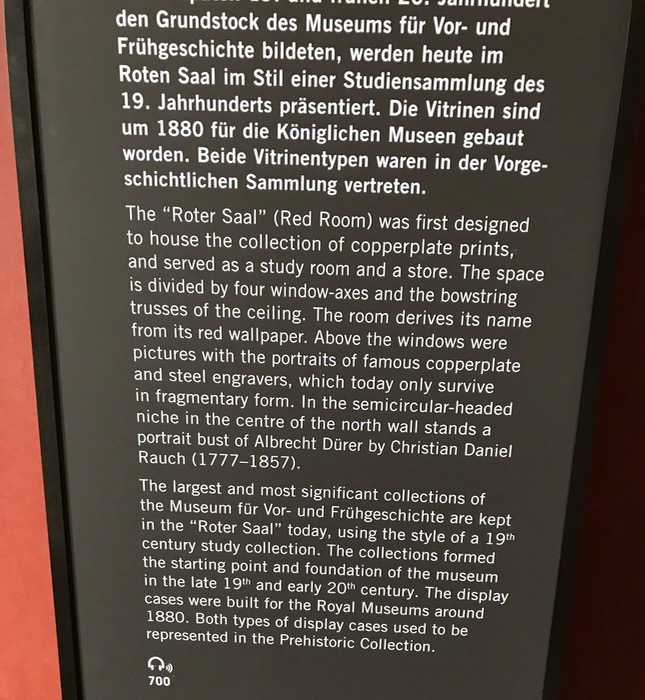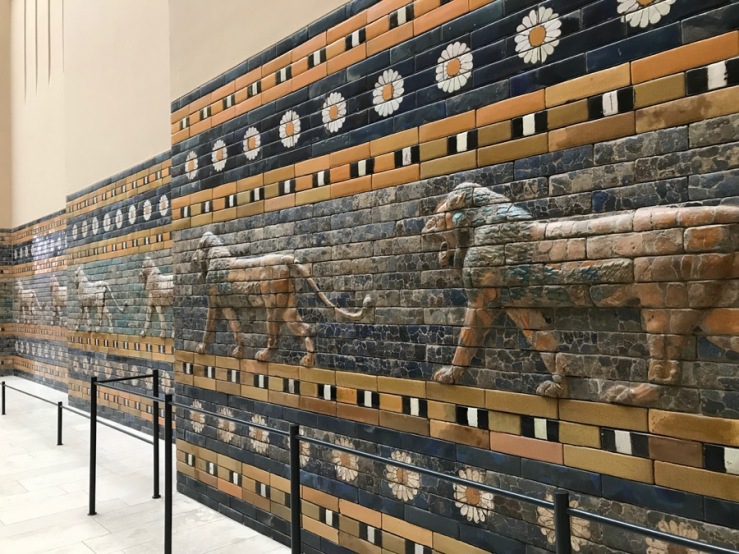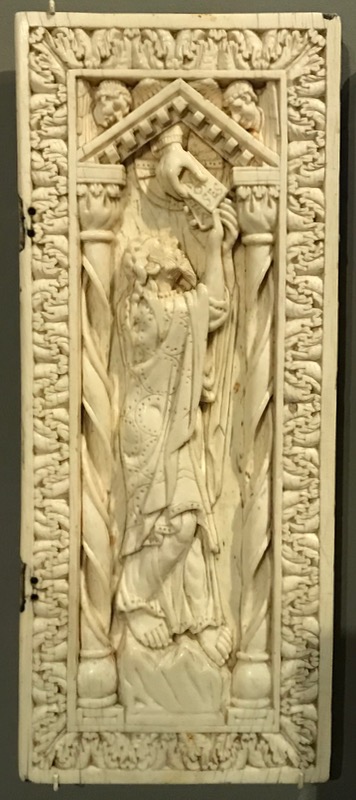This is post #18 of our Dublin-Berlin trip, for Sunday, September 23, 2018.

I’ve been on this trip so long, I decided I’d better start making an Instagram marker, just so I’d know what day it was and what the date was. But today has been set aside as Museum Day, and it’s raining raining raining, so there’s not much to keep track of. I realize, in hindsight, that it’s a good thing I didn’t try to come to Berlin when it was occupied; I would have missed most of what I’ve seen this trip. The Museum Island is in the area of former East Berlin, with its Altes and Neus Museum, the Pergamon Museum, the Old National Gallery (which we didn’t visit), and the Bode Museum (my favorite).

We arrived here mid-morning, after making arrangement at our hotel, to buy timed tickets for the Pergamon, a good decision. We toured a small street fair just across from the museums, but the sky was threatening rain, so we made our way to the Neues, which has old things in it. (I know, confusing.)

Like this Golden Hat. Made of paper-thin gold leaf (so the guidebook says), it was likely worn by the priest of a sun cult popular among the Celtics around 1000 BC.


I add these placards in here, for they tell the story better than I can, but the hat is covered in circles, a few crescent moons, with stars on the top. I was having a meta-experience while looking at this oddity, realizing that Germans may come over and see some of our best artifacts–like a torn flag–as oddities, too, although a flag is more commonplace.

This ancient lur horn, from northern Europe, had a gizmo where you could press a button and hear the strange sounds it makes, as it has no finger holes and makes “tunes” only by using the mouth.
I became quite enamored of the surface decoration of the floors, namely all the tile patterns. They even sold a postcard for this, so I’m not the only one. It’s probably like getting a fancy gift for Christmas and wanting to play with the box it came in, but I was enjoying the architecture of this place, as well as the dramatic stairwell, mid-museum:




While they had many Seriously Old items for display, the Bust of Nefertiti — glimpsed here from some distance (they had German Rules that didn’t allow photographs anywhere near it) — was one of my favorites. This 3,000-year old bust is the most famous Egyptian art piece in Europe, and arrived here in sort of an Indiana Jones-type sleight-of-hand story (Rick Steves’ words, not mine).


How do you keep the tourists from losing track of where they are? Paint the room red. I liked this room for its simplicity, and because it had ties to to writing and printing. But our time was fast approaching for the Pergamon, so we headed up there next.

The regular line to get in (above).

After getting oriented in the museum, the first draw is the Ishtar Gate, from c. 575 BC, under the reign of King Nebuchadnezzar II. It’s massive. It’s huge and blue with animals and daisies and arches and tons of people milling around. It’s hard to take it all in.




Considering that they found a lot of this in buckets of fragments, which then had to be painstakingly pieced together, it’s remarkable.

Reproductions (above) with all originals (below).


This is sort of how the gate was laid out, in the King’s time, with the Processional Way leading up to the Ishtar Gate. The lions walk against the flow in this 30-foot wide, 200-yard long road. The walls rose to 50 feet on either side.



Later on, we went upstairs, and were able to overlook the rebuilt areas, getting a sense of the scale of this thing. Apparently there is an even larger gate which the museum has, but it’s too big to display. The Ishtar Gate was the grandest of Babylon’s gates, one of eight in the 11-mile wall that encompassed this city of 200,000 people. This gate was one of the original Seven Wonders of the World (Rick Steves).

The rooms/galleries on either side of the Ishtar Gate contain more Assyrian artifacts.


This man shows examples of the first system of writing, cuneiform script, invented by the Summerians around 3500 BC. It’s called cuneiform, or “wedge-shaped” because it was made with a wedge-shaped tool pressed into a soft, clay tablet.

Another gallery, back through the Ishtar Gate was the market gate of Miletus. It reminded me of our visit to Split and Diocletian’s Palace in some ways. I liked seeing the guy who looked over the balcony.

Another notable was the Weather God Haddad, which has import because my mother loves to talk about the weather, and anything weather-related reminds me of her.




Now they tell us! We were lucky that on this trip, we didn’t encounter any “tricksters.”

We left the Museum, and walked over to the Berlin Cathedral, paying our money, putting our wet things in lockers, waiting in line just to see a darkened cathedral on this rainy day.

While ornate and certainly significant, it just didn’t have the “feel” of some of the other churches we’d been in. It appeared, as Dave noted, to have been built by man, for man. Not for God or for worshipping Him. We climbed up one set of steep stairs to grab a seat in a balcony box, next to where the Emperor/Kaiser would have sat, out of the way of the riff-raff below on the main floor.



The South Boxes, for my Emperor!

We walked out, and towards the street fair, but it had been rained out; we were glad we’d done our purchasing before.
We also had to go out and around to get the Bode Museum, which the guidebook says is skippable, but ended up being one of my favorite museums. Small, but lovely. Above left is the outside, and right is peering up into its dome.
This first hall was like entering a chapel, with its small niches filled with art on either side.

I loved this one for All the Reasons.


Veil of Christ-themed art always catches my eye, implying that the burial cloths that He was wrapped in were burned with his image at the moment of transfiguration, leaving behind his likeness. Or perhaps it’s just conflating several significant imageries into one portrait: burial cloths, thorn crowns, and the likeness of Christ.

The cover of a prayer book, showing Moses receiving the commandments. This is tiny, maybe 4 inches tall?






The carved and sometimes painted wooden statues were such fine examples of this type of art. I really loved the brilliant orange Mary from an Annunciation by Francesco di Valdambrino (1375-1435).

An example of a mosaic from Ravenna. Good. Now I can check that one off my list.


We diverged: I went upstairs and Dave went downstairs. This was my favorite of the items upstairs, with that expressive Devil and triumphant St. Michael. The wood clothing looks drapable.
Still raining, we found Cafe Orange just up a couple of blocks from the Bode, and boy, was it a welcome place. We loved our meal so much that we went there again later in the week. Good thing, because I found out that after 26 years, it closed a month after we’d eaten there. That dessert alone was worth the visit. Not a real Bavarian strudel like Austria, but good nonetheless.
We took the S-Bahn home after dinner and holed up in our hotel room the rest of the evening. Dave prepped for the next day, then almost instantly fell asleep listening to one of his audio books. I closed out the lights, looking at the Tempodrom once again, then went to bed as well.















My mom used to say that most of the cathedrals of Europe were not built for God but for power. He who has the biggest cathedral wins, I guess. The Berline Cathedral is a good example of that, isn’t it?
Berlin